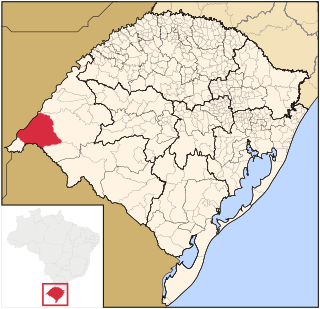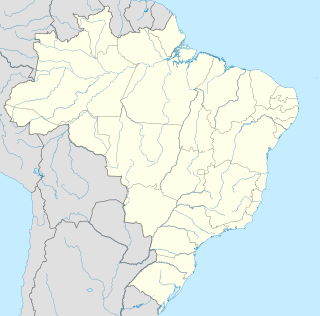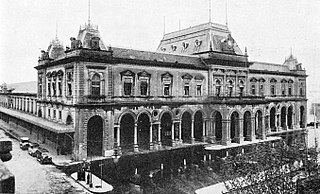Related Research Articles

Rio Grande do Sul is a state in the southern region of Brazil. It is the fifth-most-populous state and the ninth largest by area. Located in the southernmost part of the country, Rio Grande do Sul is bordered clockwise by Santa Catarina to the north and northeast, the Atlantic Ocean to the east, the Uruguayan departments of Rocha, Treinta y Tres, Cerro Largo, Rivera and Artigas to the south and southwest, and the Argentine provinces of Corrientes and Misiones to the west and northwest. The capital and largest city is Porto Alegre. The state has the highest life expectancy in Brazil, and the crime rate is relatively low compared to the Brazilian national average. Despite the high standard of living, unemployment is still high in the state, as of 2017. The state has 5.4% of the Brazilian population and it is responsible for 6.6% of the Brazilian GDP.

Uruguaiana is a municipality in the Brazilian state of Rio Grande do Sul. It is located on the left-hand (eastern) shore of the Uruguay River that forms the border with Argentina. Opposite Uruguaiana, and joined to it by a road/railway bridge, lies the Argentine city of Paso de los Libres, Corrientes. North of Uruguaiana lies the Brazilian municipality of Itaqui, connected by a bridge constructed by the English in 1888 over the Ibicuí River. The municipality also borders the municipalities of Alegrete, Barra do Quaraí and Quaraí, and, also, Uruguay, making it one of the few international triple-border municipalities of Brazil.

The Ragamuffin War was a Republican uprising that began in southern Brazil, in the province of Rio Grande do Sul in 1835. The rebels, led by generals Bento Gonçalves da Silva and Antônio de Sousa Neto with the support of the Italian fighter Giuseppe Garibaldi, surrendered to imperial forces in 1845.

The South Region of Brazil is one of the five regions of Brazil. It includes the states of Paraná, Santa Catarina and Rio Grande do Sul and covers 576,409.6 square kilometres (222,553.0 sq mi), being the smallest portion of the country, occupying only about 6.76% of the territory of Brazil. Its whole area is smaller than that of the state of Minas Gerais, in Southeast Brazil, for example.

Itaqui is a municipality in Brazil, located in the southwestern part of the state of Rio Grande do Sul, close to the Argentinian border, between Uruguaiana and São Borja. It sits at a mean altitude of 57 meters (187 ft), by the Uruguay River. Its population is currently estimated at 37,489.

Santana do Livramento is a city in the state of Rio Grande do Sul, Brazil. It is located along the border with the city of Rivera, Uruguay, forming together an international city of almost 170,000 inhabitants.

The Ibicuí River is a river in Rio Grande do Sul state of southern Brazil. The Ibicuí is 290 km in length, and is the main tributary of the Uruguay River. It is formed by the confluence of the Ibicuí-Mirim River and Santa Maria River at the city of Cacequi. The Ibicuí divides the cities of Uruguaiana and Itaqui.

Frederico Westphalen is a southern Brazilian city located in the state of Rio Grande do Sul.

Rumo, formerly known América Latina Logística (ALL), is a Brazilian logistic company, mainly focused in the railway line logistics in Brazil, being the largest company in Latin America in this segment, the company provides also transportation services such as logistics, intermodal transport, port operations, movement and storage of merchandise, administration of storage facilities and general storage. It is also involved in lease of railroad equipment to third parties, and offers road transport services in Brazil through América Latina Logística Intermodal S.A.

The Federal University of Pampa is a public university established in 2006 in the Southern region of the state of Rio Grande do Sul.

Irineu Evangelista de Sousa, the Viscount of Mauá was a Brazilian entrepreneur, industrialist, banker and politician. Born to a family of small estancieiros (ranchers), Sousa became one of the world's richest men; by 1867, his wealth was larger than the annual budget of the Brazilian Empire. He was called the Rothschild of the South American continent by the New York Times in 1871. He received the titles of baron (1854) and visconde com grandeza (1874) of Mauá. A pioneer in several areas of the economy of Brazil, one of his greatest achievements was to start the construction of the Mauá Railroad, the first railroad in Brazil.

The Uruguayan railway network has about 2900 km (1802 mi) of lines, all of 1,435 mm gauge, diesel traction with only 11 km (7 mi) of double track. Only half of the network is currently active. All the Uruguayan lines start from Montevideo, connecting the cities of Paysandú, Salto, Rivera and Río Branco. The rest of the lines (closed) connected the capital city with Fray Bentos, Cuareim, Artigas, Km. 329, Melo, La Paloma and Colonia del Sacramento.
Condor Syndikat was a German trade company, with headquarters in Berlin, that operated airline services in Brazil while also providing aircraft, maintenance and aviation information. It is also the parent company of the Brazilian airlines Varig and Syndicato Condor, which later became Serviços Aéreos Cruzeiro do Sul. They were the two oldest airlines in Brazil.
Port of Itaqui is a Brazilian port located in the city of São Luís, Maranhão. It is not to be confused with the city of Itaqui, in the state of Rio Grande do Sul, near the border with Argentina. The main cargoes include aluminum ingots and bars, pig iron, general, dry and liquid bulk cargoes, soybean and copper. The hinterland of the Port of Itaqui encompasses the states of Maranhão, Piauí, Tocantins, southwestern Pará, northern Goiás, northeastern Mato Grosso, and western Bahia.

The Central Uruguay Railway (CUR) was one of the five original rail systems in Uruguay. The other four were the Midland Uruguay Railway Co., the North Western of Uruguay, the Uruguay Northern, and the Uruguay East Coast Railway. CUR, including its leased and worked lines, was considered the most important system. It controlled about 1,560 kilometres (970 mi) of track. The system operated four sections: the Central Uruguay Railway Original Line, 436 km (271 mi); the Northern Extension Railway, 298 km (185 mi); the Eastern Extension Railway, 501 km (311 mi); and the Western Extension Railway, 340 km (211 mi).
The Uruguay Northern Railway was one of the five original rail systems in Uruguay. The other four were the Midland Uruguay Railway Co., the North Western of Uruguay, the Central Uruguay Railway, and the Uruguay East Coast Railway. The Uruguay Northern Railway Co., Ltd. was registered in London in 1887; The company's first meeting was held in November 1889 at No. 16, St. Helen's Place, Bishopsgate Street, London.
The North Western of Uruguay Railway was one of the five original rail systems in Uruguay. The other four were the Midland Uruguay, the Central Uruguay, the Uruguay Northern, and the Uruguay East Coast Railway. The North Western of Uruguay Railway Company, Ltd. was registered In London in 1882.

The Montevideo Waterworks Company, Ltd. was a British company, operating in Montevideo, Uruguay. Organized in 1879, its offices were at 61 Moorgate, London, England. The company was founded to take over a concession granted by the government of Uruguay for the construction of the necessary works for supplying the city with water derived from the Santa Lucía River. The point on that river at which the water was taken was 55 kilometres (34 mi) from the city, and after being treated with aluminoferric salt, the water was filtered and pumped through a steel main to the service reservoirs, 19 km (12 mi), on a rocky eminence at Las Piedras, at an elevation of about 90 m (300 ft) above the city. The company served nearly 35,000 houses, with the daily consumption averaging 140 litres (120 imp qt) per capita. There were six settling reservoirs, nine sand filters, two reservoirs, and five distributing reservoirs. The total extent of water mains was about 550 km (340 mi). The company assets were sold to the Uruguayan government in 1948.

Aldyr Garcia Schlee was a Brazilian writer, journalist, translator, illustrator and professor.

João Augusto Chagas Pestana was a Brazilian engineer and business leader. A key player in the partial privatization of Brazil's energy sector at the turn of the century, Pestana was the first Chairman of the Board of the company [[:pt::Rio Grande Energia|Rio Grande Energia]], now part of CPFL Energia.
References
- ↑ Gerodetti, João Emilio; Cornejo, Carlos (2005). Railways of Brazil in Postcards and Souvenir Albums. Solaris Editorial. pp. 217–. ISBN 978-85-89820-03-5 . Retrieved 26 December 2011.
- 1 2 Moody, John; Porter, John Sherman (1922). Moody's manual of investments: American and foreign: Transportation (Public domain ed.). Moody's Investors Service. pp. 1543–. Retrieved 26 December 2011.
- ↑ The Statist: a journal of practical finance and trade (Public domain ed.). Published at "The Statist" Office. 1883. pp. 112–. Retrieved 26 December 2011.
- ↑ Latin-American year book for investors and merchants for ... (Public domain ed.). Criterion Newspaper Syndicate. 1919. pp. 167–. Retrieved 26 December 2011.
- ↑ United States. Bureau of Manufactures; United States. Bureau of Foreign and Domestic Commerce (1918). Special agents series (Public domain ed.). G.P.O. pp. 158–. Retrieved 26 December 2011.
- ↑ Summerhill, William Roderick (25 August 2003). Order against progress: government, foreign investment, and railroads in Brazil, 1854-1913. Stanford University Press. pp. 64–. ISBN 978-0-8047-3224-6 . Retrieved 26 December 2011.
- ↑ Marsh, Arthur Richmond (1919). Economic world (Public domain ed.). The Chronicle Co. pp. 407–. Retrieved 26 December 2011.